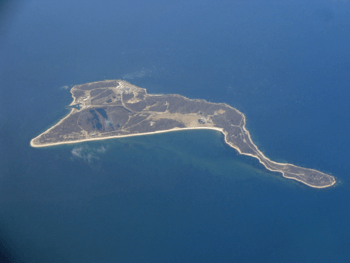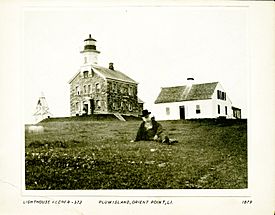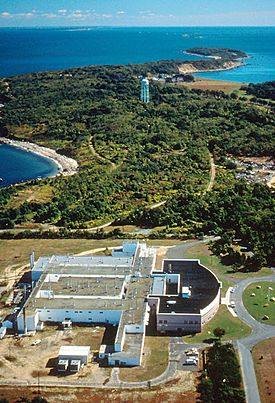Plum Island (New York) facts for kids
|
Native name:
Manittuwond
|
|
|---|---|
 |
|
|
Plum Island (New York)
|
|
| Geography | |
| Location | Block Island Sound/Long Island Sound |
| Coordinates | 41°10′59″N 72°11′25″W / 41.18306°N 72.19028°W |
| Total islands | 1 |
| Area | 840 acres (340 ha) |
| Length | 3 mi (5 km) |
| Width | 1 mi (2 km) |
| Administration | |
| State | New York |
| County | Suffolk |
Plum Island is a small island located in New York. It is part of Suffolk County, near the eastern end of Long Island. The island is about 3 miles (4.8 km) long and 1 mile (1.6 km) wide.
Plum Island is known for a few important sites. It is home to the Plum Island Animal Disease Center (PIADC). This center was started in 1954 by the United States Department of Agriculture (USDA). The island also has an old military base called Fort Terry and a historic Plum Island Lighthouse.
The United States government owns all of Plum Island. For a while, there were plans to sell the island. However, in December 2020, the U.S. Congress voted to stop the sale. This decision helps protect the island for the future.
Contents
Plum Island's Geology and Landscape
Plum Island has a unique geological makeup. The northern part of the island was formed by a moraine. This is a pile of rocks and dirt left behind by a glacier. You can still see large boulders on the northern slopes of the island. These boulders show how the glacier shaped the land long ago.
A Brief History of Plum Island
Plum Island has a rich history. The Native American Pequot Nation called the island "Manittuwond." Europeans likely first saw it in 1614. This was when a Dutch explorer named Adriaen Block mapped the area. The island got its name from the wild beach plums that grow there. An old Dutch map from around 1640 shows it as "Pruym Eyelant," meaning Plum Island.
In 1659, the island was bought from Wyandanch. He was a local Native American leader. The buyer was Samuel Wyllys III, whose father was the Governor of Connecticut. The island was traded for a coat, a barrel of biscuits, and 100 fishhooks.
Early Military Action
On August 11, 1775, during the American Revolutionary War, American soldiers landed on the island. They were immediately shot at by British forces. The Americans fired back once and then left. No one was hurt in this short fight. This event is thought to be the first time American soldiers attacked from the water.
The Plum Island Lighthouse
The historic Plum Island Lighthouse stands at the west end of the island. The first lighthouse was built in 1827. The one you see today was built in 1869. This lighthouse helps guide ships through "Plum Gut." This is a narrow channel between Plum Island and Orient Point. The currents there are very strong, so the light is important for safe travel.
Fort Terry and Its Role
After being owned by many families, the U.S. government bought Plum Island in 1899. This happened after the Spanish–American War. The government paid about $90,000 for the entire island. They built a military base called Fort Terry there in 1897.
During World War II, Fort Terry was used to protect against enemy submarines. After the war, it was closed down. Later, it was reopened and used by the Army Chemical Corps.
The Animal Disease Center
In 1954, the United States Department of Agriculture (USDA) opened the Plum Island Animal Disease Center (PIADC). This center studies animal pathogens. Pathogens are germs that cause diseases. The research helps protect farmers, ranchers, and the nation's food supply. Because of the important and sensitive work done there, access to the island is limited.
In 2003, the United States Department of Homeland Security (DHS) took over ownership of Plum Island. The USDA still does its science work at the center. The DHS makes sure the facility is safe and secure.
Protecting Plum Island's Future
After the September 11 attacks, there was talk of building a new, high-security animal disease lab. Plum Island was considered as a possible location. In 2008, Congress passed a law that said Plum Island should be sold. The money from the sale would help build the new lab somewhere else.
However, the housing market declined, making the sale of the island less practical. Also, many groups worked hard to protect Plum Island. Organizations like the Preserve Plum Island Coalition (PPIC) wanted the island to become a protected area. They suggested it could be a National Wildlife Refuge. This would allow some public access to historical areas, while protecting nature.
In 2013, a bill was introduced to stop the sale. This bill aimed to protect the island's unique plants and animals. New York's Governor also asked for a plan to clean up the island before any sale.
In 2015, environmental groups threatened to sue. They argued that selling the island would harm endangered species. Senators from New York and Connecticut also asked Congress to stop the sale. They said the original reasons for selling the island were no longer valid.
Finally, on December 21, 2020, Congress voted to block the sale of Plum Island. This was a big win for conservation efforts. The law says the island should first be offered to other federal agencies, like the United States Fish and Wildlife Service. If no federal agency wants it, it can be offered to state and local governments. The law also provides money to clean up any pollution on the island. President Donald Trump signed this law on December 27, 2020. This means Plum Island will be preserved for its natural and historical value.
Plum Island in Pop Culture
Plum Island has appeared in many books and TV shows.
- The 1988 book The Silence of the Lambs mentions Plum Island. It is called "Anthrax Island" in the story.
- Plum Island is a 1997 novel by Nelson DeMille. The island is a main setting in this book.
- The 2004 book Lab 257: The Disturbing Story of the Government's Secret Plum Island Germ Laboratory by Michael Carroll looks into the Plum Island Animal Disease Center.
- The TV show Conspiracy Theory with Jesse Ventura had an episode about Plum Island in 2010.
- Plum Island is mentioned in an episode of the show Royal Pains.
- The 2014 novel The Montauk Monster by Hunter Shea uses Plum Island as a place for a government conspiracy.
- The 2016 novel Game Changer by Douglas E. Richards sets a lab on Plum Island.
- The post-apocalyptic Extinction Cycle series by Nicholas Sansbury Smith features Plum Island. It is where the U.S. government tries to stop a deadly virus.
- "Plum Island" is a song by the band Waterparks. It is on their album, Double Dare.
- Plum Island is mentioned in season 3 of the Netflix series Hemlock Grove.
- Plum Island is a setting for parts of the ABC series Emergence.
- The TV show What We Do in the Shadows mentions Plum Island in season 3.
- Plum Island is used as a setting in the 11th season of American Horror Story.
- Plum Island and its building 257 are mentioned in the TV series World War Weird.
Images for kids
See also
 In Spanish: Isla Plum (Nueva York) para niños
In Spanish: Isla Plum (Nueva York) para niños






